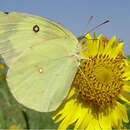Conservation Status
provided by University of Alberta Museums
Not of concern; a very rare stray.
- license
- cc-by-nc
- copyright
- University of Alberta Museums
Cyclicity
provided by University of Alberta Museums
Should be watched for in late summer (Bird et al. 1995).
- license
- cc-by-nc
- copyright
- University of Alberta Museums
Distribution
provided by University of Alberta Museums
Breeding resident throughout South and Central America north to the southernmost U.S., migrating and colonizing northward occasionally as far north as southern Canada (Opler 1999). The only Alberta specimen was collected by Art Rupp in Didsbury during the 1940s (Bird et al. 1995).
- license
- cc-by-nc
- copyright
- University of Alberta Museums
General Description
provided by University of Alberta Museums
The pattern of the black forewing border, resembling a dog's (poodle's?) face, is unmistakable. While flying, however, this species resembles the Common Sulphur (Colias philodice) (Nielsen 1999).
- license
- cc-by-nc
- copyright
- University of Alberta Museums
Habitat
provided by University of Alberta Museums
A rare stray in Alberta, most likely to be encountered in the southern third of the province.
- license
- cc-by-nc
- copyright
- University of Alberta Museums
Life Cycle
provided by University of Alberta Museums
The larvae are green or yellow with hairy, black tubercles and a combination of black and yellow stripes and / or black and yellow bands (Layberry et al. 1998). This species is not able to overwinter in Canada, and occurs only as a rare stray (Layberry et al. 1998).
- license
- cc-by-nc
- copyright
- University of Alberta Museums
Trophic Strategy
provided by University of Alberta Museums
Larvae feed on many species of legumes (Opler 1999).
- license
- cc-by-nc
- copyright
- University of Alberta Museums

